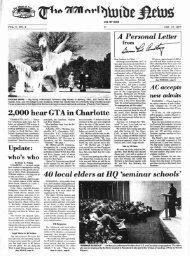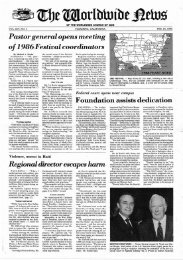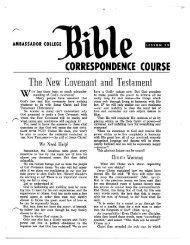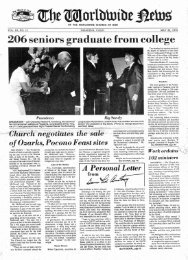Plain Truth 1977 (Prelim No 10) Dec - Herbert W. Armstrong
Plain Truth 1977 (Prelim No 10) Dec - Herbert W. Armstrong
Plain Truth 1977 (Prelim No 10) Dec - Herbert W. Armstrong
You also want an ePaper? Increase the reach of your titles
YUMPU automatically turns print PDFs into web optimized ePapers that Google loves.
we would expect thei r growth was<br />
lim ited by some climatic factorusually<br />
rainfall.<br />
Dendrochronologists Dr. Valmore<br />
C. LaMarche and Dr. Harold C.<br />
Fritts have demonstrated that we<br />
can acq uire a greater understand ing<br />
of climatic fluct uations and wea ther<br />
pa tterns over the past several tho usand<br />
years by examining bristlecone<br />
tree-ring patterns. Such studies, they<br />
believe, give valuable insig hts into<br />
futur e climatic trends, such as the<br />
potential for a new ice age .<br />
Recalibrating Carbon 14<br />
Yet perhaps the most significant result<br />
of the bristlecone pine tree -ring<br />
chronology is its revolution ary implications<br />
for the ca rbon- 14 dating<br />
method and our understand ing of<br />
prehistory.<br />
What do bristlecone pines ha ve to<br />
do with carbon 14? All living things,<br />
including the bristlecone pine, contain<br />
a sm all amount of the radioactive<br />
element carbon 14. When an<br />
organi sm dies, the carbon 14 begins<br />
to decay at a known rate . By measuring<br />
the amount of rem aining carbon<br />
14 in a once living organism,<br />
scientists can closely estimate whe n<br />
that organism died.<br />
But the radiocarbon dating technique<br />
is based on the questio nable<br />
assumption that the amount of carbon<br />
14 available to be incorporated<br />
into living orga nisms has remained<br />
constant for thousands of years.<br />
Since carbon- 14 concentrations<br />
have been measured only in the past<br />
four decades, scien tists could only<br />
assume that the same carbon- 14<br />
concentration applied to those past<br />
eras where no historical da ta was<br />
ava ilable as a check. Indeed, without<br />
that assumption, or at least<br />
some method of calibration, the ra <br />
diocarbon dating method would be<br />
largely worthless.<br />
Enter bristlecone pine. The 8,200 <br />
year sequence of bristlecone rings<br />
has provided a remarkable check on<br />
the primary assumption of radiocarbon<br />
dating. As each ring in a<br />
seq uence grew , it recorded the carbon-14<br />
concentration in the atmosphere<br />
at that time. By measuring<br />
the carbon- 14 content of various<br />
rings, scientists were able to check<br />
the accuracy of the radiocarbon dating<br />
method. The conclusion of<br />
The PLAIN TRUTH <strong>Dec</strong>ember <strong>1977</strong><br />
man y yea rs of research at the Universities<br />
of Arizon a, Pennsylvan ia,<br />
and Ca liforn ia is that the basic assumption<br />
of radi ocarbon dating is<br />
not 'gross ly in error. Indeed, the<br />
bristlecone studies have shown that<br />
radi ocarbon dating is generally accurat<br />
e over the past 3,000 years.<br />
Older by 900 Years<br />
But the bristlecone calibration also<br />
produced something unexpected :<br />
As we go back in time prior to abo ut<br />
1,000 B.C., th e amount of carbon 14<br />
in the environme nt was somewhat<br />
greater than at present. This mean s<br />
that cert ain samples dated by radi ocarbon<br />
will be dated too yo ung. In<br />
other word s, the bristlecone pine<br />
calibration has shown that some archaeological<br />
sa mples should ac <br />
tually be dated up to 900 years older<br />
(earlier) than conventional carbon<br />
14 ana lysis would ind icate!<br />
Th e bristlecon e calibration of radiocarbon<br />
has drastically chan ged<br />
the archaeologist's understanding of<br />
some ea rly cultures, especi ally in<br />
Europe. A leading British archa eologi<br />
st, Colin Renfrew, believes th e<br />
bristlecone pine will revolutionize<br />
our chronology of the deve lopment<br />
of early European civilization .<br />
Using the calibrated rad iocarbon<br />
dat es.. Renfrew contends that mega<br />
lithic tombs of western Eu rop e<br />
are actua lly older than the Egyptian<br />
pyramids ( w h ic h a r e usually<br />
thou ght to pred ate the Eu rop ean<br />
tombs). He also asserts that Britain 's<br />
Stonehenge, once thought to have<br />
been ins pi red by M ycenaean<br />
(Greek) bui lders , actua lly was completed<br />
well before the Mycenaean<br />
civilization began . "<strong>No</strong> w it is clear,"<br />
says Renfrew, " tha t megalithic<br />
chamber tombs were being built in<br />
Britt any ... a millennium before<br />
monumental funerary architecture<br />
first appears in the eastern Med iterran<br />
ean and 1500 years before the<br />
raising of the pyramids."<br />
Multiple Rings and the<br />
Appearance of Age<br />
According to Renfrew, the bristlecon<br />
e ca libration make s obso lete the<br />
formerly accepted theory that prehistoric<br />
culture began in the Ne ar<br />
East and was only later diffu sed into<br />
" ba rba ric" Europe.<br />
(Co ntinued on page 37)<br />
21

















